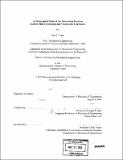A tribological study of the interaction between surface micro texturing and viscoelastic lubricants
Author(s)
Hupp, Sara J. (Sara Jean), 1979-
DownloadFull printable version (19.75Mb)
Other Contributors
Massachusetts Institute of Technology. Dept. of Mechanical Engineering.
Advisor
Douglas P. Hart.
Terms of use
Metadata
Show full item recordAbstract
An experimental study is performed on micro textured surfaces using both elastic and Newtonian fluids in order to understand the effect of surface texturing and fluid rheology on sliding friction under lubricated conditions. Nickel micro textured surfaces containing 50 to 125 micron diameter pores and 1 to 20 percent area densities of pores are fabricated using novel techniques inspired by MEMS fabrication methods in order to obtain a metal surface that is corrosion and wear resistant. These surfaces are then friction tested using a torsional rheometer with a parallel plate configuration, and the resulting data is normalized to obtain a Stribeck diagram that spans the lubrication regimes from boundary lubrication to hydrodynamic lubrication. Each lubricant/surface pair results in a unique curve that is subsequently compared to other lubricant/surface pairs in order to study the effect of different surface texturing parameters as well as the effect of the particular lubricant rheology. Experimental results from studying the effect of different surface texturing parameters indicate that particular micro textured patterns can reduce friction by as much as seventy-five percent after a controlled break-in period. Data from the tribo-rheometer also indicates that along with a reduction in friction, micro texturing can result in shifting the entire Stribeck curve so that the transition points between lubrication regimes are delayed or induced by as much as an order of magnitude of the Gumbel number, depending on the lubricant and running conditions. Focusing next on the effect of lubricant rheology on sliding friction over micro textured surfaces, this research reveals that the Stribeck curve will experience a shift according to the lubricant elasticity. A new dimensionless number formed by dividing the Gumbel number by the elasticity factor of the fluid can accurately account for the Stribeck curve shift as a result of fluid elasticity.
Description
Thesis (S.M.)--Massachusetts Institute of Technology, Dept. of Mechanical Engineering, 2004. Includes bibliographical references (p. 116-117).
Date issued
2004Department
Massachusetts Institute of Technology. Department of Mechanical EngineeringPublisher
Massachusetts Institute of Technology
Keywords
Mechanical Engineering.